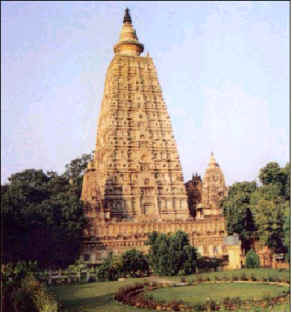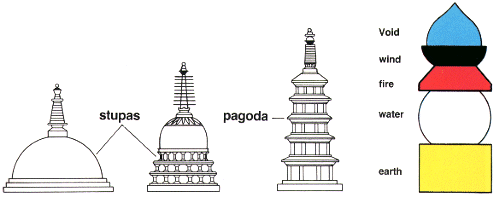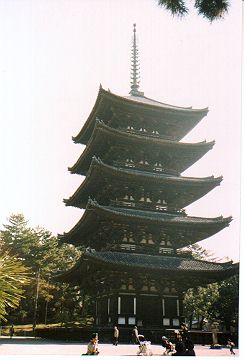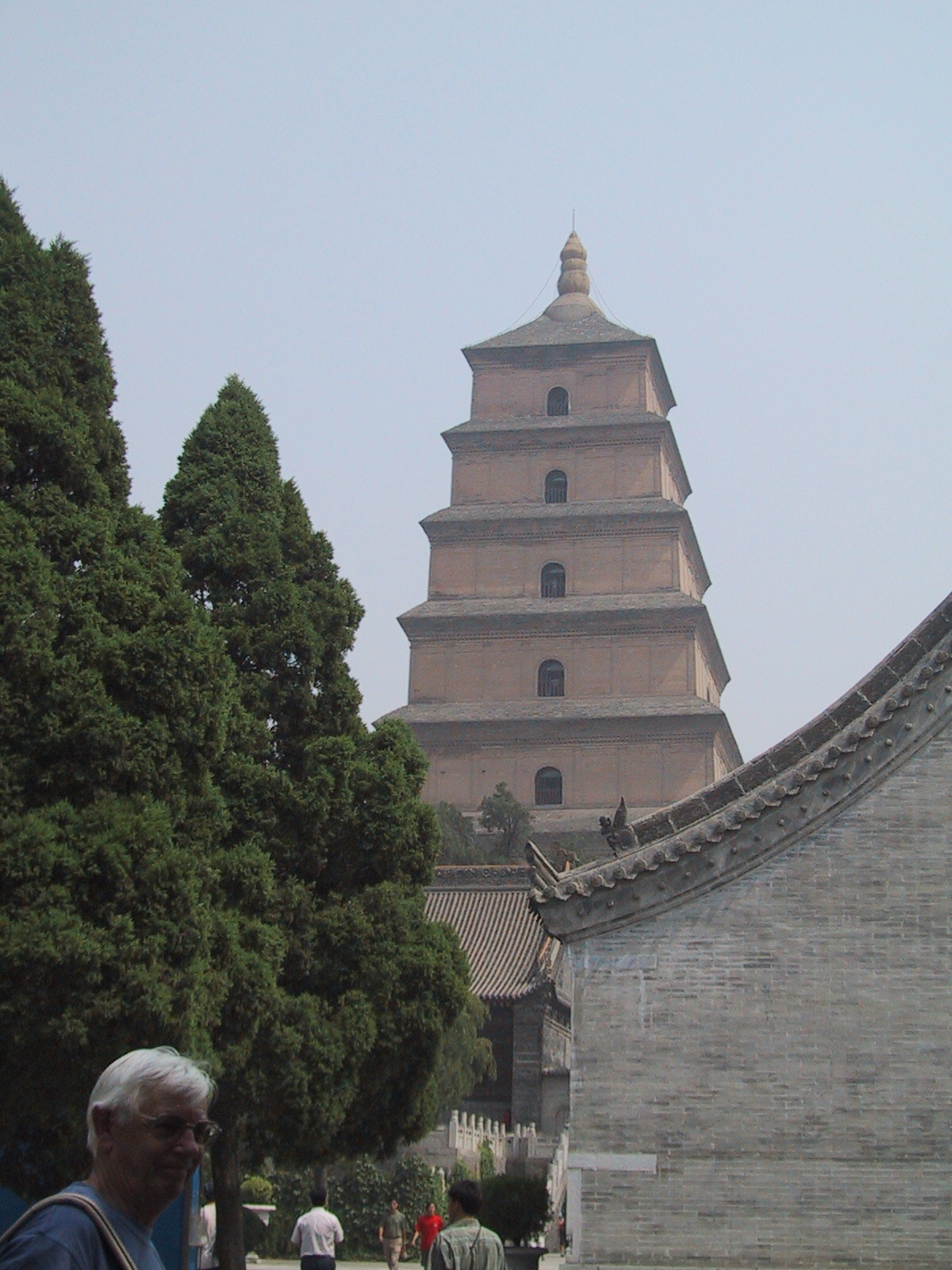
![]()
During Buddha's life on this earth, there has been numerous temple as a gift from the kings of the region to the Buddha and his disciple. there is written records that, after Buddha's enlightenment, King of Bimbisara took refuge under the Buddha and donated Veluvana Park to Buddha and the monks and became the first Buddhist monastery. Veluvana park became the conference place or discourse meeting between Buddha and the monks numbering some thousands. Some of the description of this temples during Buddha's life can be traced from various writings of monks on pilgrimage to India before the decline of Buddhism in India. Writings of Fa Hsien and Xuan Tsang (7th century) (Mokshdeva) gives full description of this temples.
 The
monastery in Bodhgaya
The
monastery in Bodhgaya
The Architecture of the Indian Buddhist Temple
The architecture of Indian Buddhist temple are developed from the pre-Buddhist Indian grave mound. Under these mounds the saintly ascetic were buried; their bodies were seated on the ground and covered with earth. These dome-shaped graves, or tumuli, of the saints were regarded as holy places. Hence the design of this religious monuments corresponds to the
perfect proportions of the Buddha’s body
 The
great Stupa in Sri Lanka
The
great Stupa in Sri Lanka
A look at the Ruwanweliseya, or the "Great Stupa", is regarded as the most important of the stupas at Anuradhapura, Sri Lanka. Standing at 300 feet, it is the oldest but smallest of the three giant edifices in brick in the world. This stupa design has been repeated in Thailand, Burma, and other countries where Buddhism was taught by monks from Sri Lanka.
The Analogy with the Symbolism of the Stupa

- The Seed of Highest Enlightenment, also depicted as a Tongue of Flame (Bindu) to be realized above the double symbol crowning Chorten.
- The double symbol (Surya Chandra) of Sun and Rising Moon is an emblem of the Twin-unity of the Absolute Truth (of the sphere beyond normal comprehension) and the Relative Truth (of the worldly sphere).
- The stylized Parasol (Chattra) symbolically giving protection from all evil.
- The thirteen Steps of Enlightenment, i.e. the first ten Steps of Enlightenment (Dasha-Bhumi) and the three higher levels of supraconsciousness (Avenika-smrityupashthana).
- The dome, corresponding to the primeval mound, as Receptacle of Relics or offerings (Dhatu-Garbha); the dome-line edifices of Old Indian Stupas were also called egg or water-bubble (Budbuda).
- The base (Parishada) is square and four-stepped, its sides facing the four directions. Analogous to the underworld.
 The
stupa in Tibet.
The
stupa in Tibet.
Hence, it is the same meaning applies to the Chinese pagoda, where the Chinese took it's form from the Indian Stupa but building it higher, to become a watch tower in war times, bell tower in temples. In conclusion, pagoda in China explains and reflects the meanings of Buddha's enlightenment and his passing. That is why most of Buddhist temple is seen in the form of verticality. But then again, the original meaning of the stupa is just the size of a human or holyman, the sizes of the pagoda and stupas are huge today.

The Chinese Buddhist Pagoda
Chinese Buddhist architecture consists of temple, pagoda and grotto. Localization starts right after Buddhist architecture was introduced into China with Buddhism during the Han dynasty, interpreting Chinese architectural aesthetics and culture.
 Chinese
Buddhist architecture follows symmetric style strictly as discussed before.
Usually main buildings will be set on the central axis, facing the south.
Annexe structures will be on the west and east flanks. Temple gate,
Heavenly King Hall, the Main Hall and Sutra Library successively stands on
the axis. Dorm, kitchen, dinning hall, storehouse and antechamber usually
cluster on the right side while left side remains for the visitors.
Chinese
Buddhist architecture follows symmetric style strictly as discussed before.
Usually main buildings will be set on the central axis, facing the south.
Annexe structures will be on the west and east flanks. Temple gate,
Heavenly King Hall, the Main Hall and Sutra Library successively stands on
the axis. Dorm, kitchen, dinning hall, storehouse and antechamber usually
cluster on the right side while left side remains for the visitors.
Pagoda is also the main integrating part of the Buddhist architecture, with varied styles and strong local flavours. Pagoda followed Buddhism into China around the first century, and developed into pavilion-like pagoda on which one can view scenery after immediate combination with traditional Chinese architecture. Now the highest pagoda existing stands 40 meters high and enjoys a 1400-year lifespan after survival of several earthquakes. Among the 3000 existing pagodas, there are all-timber pagoda, brick pagoda, stone pagoda, bronze pagoda and iron pagoda.
 Most
Chinese pagodas are multistoried ones. Early pagodas were usually wooden
and had quadrangle, hexangle, ocatagonal and twelve sided ichnographies.
During the Sui and Tang dynasties, pagodas tended to be stone and brick.
In the Liao Dynasty, solid pagoda appeared. After, in the Song, Liao and
Jin dynasties, flower pagodas were introduced which were decorated with
assorted carved flowers, honeycombed shrines, animals and Buddha and
disciple sculptures, looked like flowers. Generally speaking, pagodas
became more and more decorative.
Most
Chinese pagodas are multistoried ones. Early pagodas were usually wooden
and had quadrangle, hexangle, ocatagonal and twelve sided ichnographies.
During the Sui and Tang dynasties, pagodas tended to be stone and brick.
In the Liao Dynasty, solid pagoda appeared. After, in the Song, Liao and
Jin dynasties, flower pagodas were introduced which were decorated with
assorted carved flowers, honeycombed shrines, animals and Buddha and
disciple sculptures, looked like flowers. Generally speaking, pagodas
became more and more decorative.
Previous Next
![]() This
is a thesis website by ressox studio.
This
is a thesis website by ressox studio.

